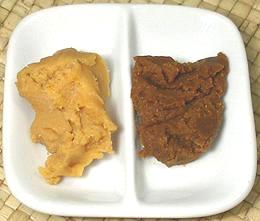
Fermented soybean paste was invented in China during the Chou Dynasty (1132-246 BCE) and was the first really successful method to render soybeans edible - and it also produced a very usable byproduct - tamari soy sauce. Both these products are too strong in flavor to be used alone, but they have both become indispensable flavoring ingredients - though most soy sauce is now made by a different process.
The fermenting technique was taken to Japan around 600 CE and was further refined there into today's miso. Originally miso was made by fermenting whole soybeans, but from around 1400 on it has been made from ground soybeans. Similar products are made in Korea and China but differ in style.
There are a great many misos with subtle flavor differences but for most purposes you need consider only the two in the photo: Shiromiso (white) and Akamiso (red). The other two most common types are Kuromiso (black) and Hatchomiso (aged or smoked) but those are a lot harder to find in the US. Typically the ingredients are: water, soybeans, rice, salt and alcohol. Other mixes of grains and/or soybeans and grains are used to make miso. Fermentation with koji-kin mold (Aspergillus oryzae) ranges in time from a week to several years.
More on Products from Beans.
Other than that, just follow the directions given for your recipe for both type of miso and cooking. Health food enthusiasts often don't add miso to a recipe until it has cooled in order to keep the mold culture alive, but this is not normally done in Japan.
Aside from soup miso is used in some pickles, along with sake as a marinade for fish, and as part of the liquid for braised vegetables. In Japan corn on the cob is often made by coating the ear lightly with shiro miso, wrapping it in foil and grilling it.
Miso is high in salt which is necessary to the fermentation process and is of no use to persons trying to reduce their blood pressure with a salt free diet. Medical sources say reducing sodium has little effect until nearly all salt is eliminated from the diet.
In my non-medical opinion this sounds like treating the symptoms, not the disease, by creating an imbalance so extreme it happens to counter symptoms of the real problem. As usual, I point to demographics. Populations that practically live on salt, like Japan, don't seem to have that much of a high blood pressure problem.
Because natural miso is a long fermented product, it is free from the toxins and hormone-like substances some soy products are suspected of and is generally considered safe.
Claims that miso contains vitamin B12 (critically deficient in the vegan diet) have not stood up to scientific investigation. Miso has B vitamins but not B12, unless it has been contaminated with insects. Miso has been used as a treatment for radiation sickness, basically on hear-say evidence since controlled human studies have not been politically practical since the fall of the Japanese Empire.
bp_soymz 080923 - www.clovegarden.com